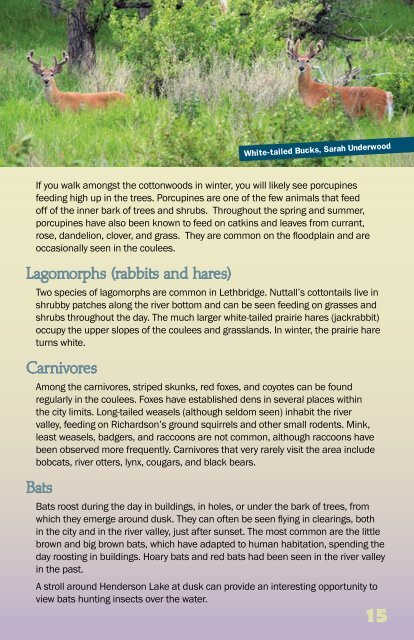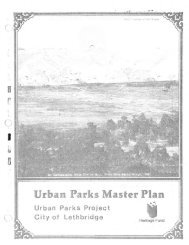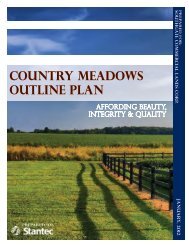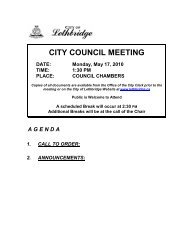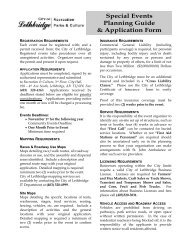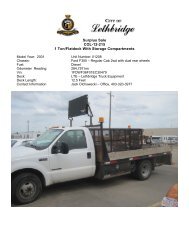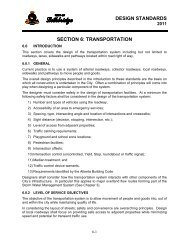Coulees Cottonwoods - City of Lethbridge
Coulees Cottonwoods - City of Lethbridge
Coulees Cottonwoods - City of Lethbridge
You also want an ePaper? Increase the reach of your titles
YUMPU automatically turns print PDFs into web optimized ePapers that Google loves.
If you walk amongst the cottonwoods in winter, you will likely see porcupines<br />
feeding high up in the trees. Porcupines are one <strong>of</strong> the few animals that feed<br />
<strong>of</strong>f <strong>of</strong> the inner bark <strong>of</strong> trees and shrubs. Throughout the spring and summer,<br />
porcupines have also been known to feed on catkins and leaves from currant,<br />
rose, dandelion, clover, and grass. They are common on the floodplain and are<br />
occasionally seen in the coulees.<br />
Lagomorphs (rabbits and hares)<br />
Two species <strong>of</strong> lagomorphs are common in <strong>Lethbridge</strong>. Nuttall’s cottontails live in<br />
shrubby patches along the river bottom and can be seen feeding on grasses and<br />
shrubs throughout the day. The much larger white-tailed prairie hares (jackrabbit)<br />
occupy the upper slopes <strong>of</strong> the coulees and grasslands. In winter, the prairie hare<br />
turns white.<br />
Carnivores<br />
Among the carnivores, striped skunks, red foxes, and coyotes can be found<br />
regularly in the coulees. Foxes have established dens in several places within<br />
the city limits. Long-tailed weasels (although seldom seen) inhabit the river<br />
valley, feeding on Richardson’s ground squirrels and other small rodents. Mink,<br />
least weasels, badgers, and raccoons are not common, although raccoons have<br />
been observed more frequently. Carnivores that very rarely visit the area include<br />
bobcats, river otters, lynx, cougars, and black bears.<br />
Bats<br />
White-tailed Bucks, Sarah Underwood<br />
Bats roost during the day in buildings, in holes, or under the bark <strong>of</strong> trees, from<br />
which they emerge around dusk. They can <strong>of</strong>ten be seen flying in clearings, both<br />
in the city and in the river valley, just after sunset. The most common are the little<br />
brown and big brown bats, which have adapted to human habitation, spending the<br />
day roosting in buildings. Hoary bats and red bats had been seen in the river valley<br />
in the past.<br />
A stroll around Henderson Lake at dusk can provide an interesting opportunity to<br />
view bats hunting insects over the water.<br />
15


